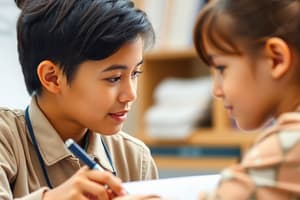Podcast
Questions and Answers
What is the primary purpose of the listening macro skill?
What is the primary purpose of the listening macro skill?
- To share ideas verbally
- To learn how to write effectively
- To understand the spoken language (correct)
- To critique written text
Which component of information literacy involves recognizing the need for information?
Which component of information literacy involves recognizing the need for information?
- Find
- Identify (correct)
- Apply
- Evaluate
In the context of information literacy, what does the 'Evaluate' component focus on?
In the context of information literacy, what does the 'Evaluate' component focus on?
- Seeking out new information for personal knowledge
- Determining the ethical implications of information
- Comparing and assessing information from various sources (correct)
- Organizing information into relevant categories
Which macro skill is primarily associated with the ability to share ideas verbally?
Which macro skill is primarily associated with the ability to share ideas verbally?
What is involved in the 'Acknowledge' component of information literacy?
What is involved in the 'Acknowledge' component of information literacy?
What distinguishes listening from hearing?
What distinguishes listening from hearing?
Which of the following is NOT a reason why we listen?
Which of the following is NOT a reason why we listen?
Which element is NOT part of the listening process?
Which element is NOT part of the listening process?
What type of listening focuses on comprehending the information being conveyed?
What type of listening focuses on comprehending the information being conveyed?
Which type of non-verbal communication does NOT directly involve physical gestures or movements?
Which type of non-verbal communication does NOT directly involve physical gestures or movements?
Which type of listener actively participates in a discussion and pays full attention?
Which type of listener actively participates in a discussion and pays full attention?
What barrier to effective listening involves judging the speaker's worth before fully understanding the message?
What barrier to effective listening involves judging the speaker's worth before fully understanding the message?
Which purpose of listening focuses on understanding the main idea in a discussion?
Which purpose of listening focuses on understanding the main idea in a discussion?
In the context of listening types, which listener separates informational content from non-informational content?
In the context of listening types, which listener separates informational content from non-informational content?
Which barrier to effective listening refers to the overwhelming amount of information that can make it difficult to process during a conversation?
Which barrier to effective listening refers to the overwhelming amount of information that can make it difficult to process during a conversation?
What is the primary goal of critical/analytical listening?
What is the primary goal of critical/analytical listening?
Which of the following is NOT a type of non-verbal communication?
Which of the following is NOT a type of non-verbal communication?
What main aspect distinguishes appreciative listening from informational listening?
What main aspect distinguishes appreciative listening from informational listening?
Which type of listening may lead to misleading input due to distraction or lack of interest?
Which type of listening may lead to misleading input due to distraction or lack of interest?
In evaluating the worth of a speaker's message, which aspect is primarily considered?
In evaluating the worth of a speaker's message, which aspect is primarily considered?
What is the primary function of an Expository Organizer?
What is the primary function of an Expository Organizer?
Which of the following best describes a Venn Diagram?
Which of the following best describes a Venn Diagram?
What is the main purpose of using flowcharts or sequence charts?
What is the main purpose of using flowcharts or sequence charts?
Which type of text is characterized by being instructional and providing steps to follow?
Which type of text is characterized by being instructional and providing steps to follow?
What does K-W-L stand for in educational settings?
What does K-W-L stand for in educational settings?
What is the primary purpose of textual aids?
What is the primary purpose of textual aids?
Which of the following is NOT considered a textual aid?
Which of the following is NOT considered a textual aid?
What does the term 'text features' refer to?
What does the term 'text features' refer to?
How do textual aids assist readers in understanding a text?
How do textual aids assist readers in understanding a text?
Which of the following is an example of a textual aid?
Which of the following is an example of a textual aid?
What is the primary purpose of factual texts?
What is the primary purpose of factual texts?
Which of the following best describes instructional texts?
Which of the following best describes instructional texts?
What defines a literary genre?
What defines a literary genre?
Which type of non-fiction text is likely to persuade you to take a specific action?
Which type of non-fiction text is likely to persuade you to take a specific action?
Which of the following is NOT typically included in prose narratives?
Which of the following is NOT typically included in prose narratives?
What is a common feature of explanatory texts?
What is a common feature of explanatory texts?
What is one primary purpose of poetry according to the content?
What is one primary purpose of poetry according to the content?
How does free style writing differ from more structured forms of literature?
How does free style writing differ from more structured forms of literature?
Which of the following statements best represents literary texts?
Which of the following statements best represents literary texts?
Which of the following is a characteristic of literary figures in free style writing?
Which of the following is a characteristic of literary figures in free style writing?
What distinguishes the subjectivity of literary texts?
What distinguishes the subjectivity of literary texts?
Which of the following best describes the role of literary figures in writing?
Which of the following best describes the role of literary figures in writing?
What is a primary characteristic of poetic texts?
What is a primary characteristic of poetic texts?
In what way does the credibility of a literary text function?
In what way does the credibility of a literary text function?
What is the primary purpose of literary texts?
What is the primary purpose of literary texts?
What is the primary function of illustrations in text features?
What is the primary function of illustrations in text features?
Which of the following best describes a line graph?
Which of the following best describes a line graph?
What type of map includes labels for features such as cities and states?
What type of map includes labels for features such as cities and states?
What distinguishes a pictograph from a bar graph?
What distinguishes a pictograph from a bar graph?
In what way do tables organize information?
In what way do tables organize information?
Flashcards are hidden until you start studying
Study Notes
Core Macro Skills
- Listening: Vital for effective communication, involving understanding spoken language.
- Speaking: Essential for verbally sharing and articulating ideas.
- Writing-Viewing: Key for learning language through written expression.
- Reading: Critical for comprehending and interpreting text.
Information Literacy
- Definition: Ability to recognize when information is needed and to locate, evaluate, and use it effectively.
- Components: Involves skills in writing, reading, speaking, and listening.
Components of Information Literacy
- Identify: Recognizing the need for information.
- Find: Knowing various means to locate information efficiently.
- Evaluate: Comparing information accuracy and reliability from different sources.
- Apply: Organizing and relating new information to existing knowledge.
- Acknowledge: Understanding and addressing ethical and socio-economic issues regarding information.
Listening Skills
- Listening Process:
- Hearing: Receiving and processing sound.
- Attending: Selecting what to focus on.
- Understanding: Interpreting the message.
- Remembering: Retaining information.
- Evaluating: Judging the message's validity.
- Responding: Providing feedback.
Types of Listening
- Informational: For comprehension and detail retention.
- Critical/Analytical: For evaluation and analysis.
- Appreciative: For enjoyment and aesthetic pleasure.
- Marginal: Inconsistent focus, leading to potential misunderstanding.
- Emphatic/Therapeutic: To understand speaker emotions and thoughts.
- Inspirational: For emotional support and motivation.
Non-Verbal Communication
- Facial Expressions: Key indicators of emotions.
- Body Movement and Gestures: Reflects personal engagement and understanding.
- Eye Contact: Builds connection and trust.
- Touch: Can convey support or empathy.
- Space: Personal distance impacts interactions.
Challenges in Listening
- Physical, emotional, cultural, or psychological barriers can hinder effective listening.
- Other obstacles include time pressures, interruptions, information overload, bias, and selective listening.
Effective Listening Strategies
- Active Listening: Full participation in discussions, offering feedback.
- Critical Evaluation: Analyzing speaker credibility and content without bias.
- Impatience Management: Distinguishing essential information from distractions and background noise.
Informative Talks and Panel Discussions
- Aimed at delivering specific information to enhance listeners' understanding.
- Requires varying levels of listening—from gist comprehension to detailed analysis.
Textual Aids
- Aid comprehension through visual elements such as titles, subtitles, and illustrations.
- Non-textual elements enhance understanding and context.
Types of Textual Features
- Illustrations: Visual representations for clarity.
- Tables and Graphs: Organized data presentations; bar, line, pie, and pictographs convey relationships.
- Maps: Geographic representations illustrating various characteristics.
Avoiding Information Overload
- Set limits and prioritize information to manage and organize effectively.
- Use organizers (e.g., K-W-L charts) to connect new information with existing knowledge.
Types of Organizers
- Expository Organizer: Clearly presents new content.
- Comparative Organizer: Distinguishes between old and new concepts.
- Flowchart/Sequence Chart: Displays ordered events.
- Venn Diagram: Illustrates relationships among concepts.
Types of Texts
- Factual Texts: Endeavors to inform, instruct, or persuade.
- Literary Texts: Include fiction and non-fiction narratives dealing with human experiences.
Characteristics of Literary Texts
- Poetic Intention: Evokes aesthetic experiences through various styles.
- Subjectivity: Offers original perspectives, often departing from objective reality.
- Fiction: Engages creativity and storytelling to convey distinct viewpoints.
Types of Poems
- Include epic, ballad, sonnet; use of rhyme and rhythm dictates structure and emotional conveyance.
Studying That Suits You
Use AI to generate personalized quizzes and flashcards to suit your learning preferences.




